One of the simple methods to increase the living space in a private house is to remodel the attic space under the attic. To use it all year round, you need to insulate the roof. Typically, roof insulation is done during construction prior to laying the roofing material. If the roof is already covered, insulation is performed from the inside. Thermal insulation of the attic is not difficult to do independently, picking up all the necessary materials.
Content
What is an attic
The attic in a private house differs from the usual attic in a large size. The ceiling height in such a room is more than 2.5 m. In the rest of the space it resembles an ordinary attic. It is protected by a system of rafters, on which the roof material is laid. Under the gable roof, the attic is fenced on both sides by gables in which they make windows or a doorway leading to the adjacent balcony. But the role of the main walls is performed by the slopes of the roof, located at an angle.
Between the rafters and roofing material they make waterproofing. It will protect wooden elements from rainfall from the roof. For waterproofing, rolled materials are often laid on the roof in the form of strips going down from the ridge. Tapes overlap and fasten to the rafter legs. The material is not tightly stretched to avoid damage from temperature changes. The edges of the tapes must be connected with a self-adhesive tape.
Then, along the rafters, wooden slats are beaten for counter-lattice. Perpendicular to them mount the details of the crate. Roofing material is laid and fixed on it.
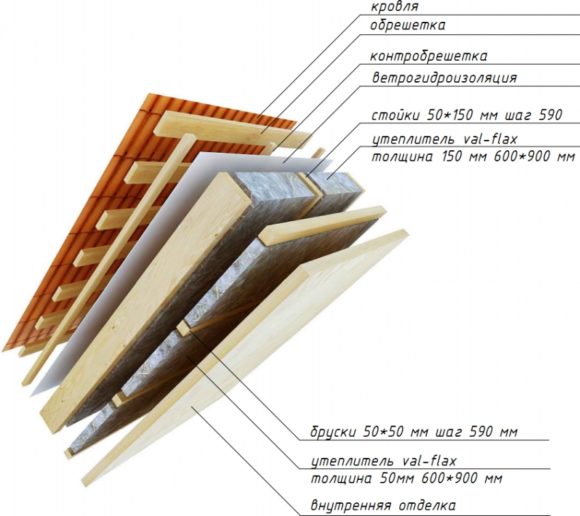
Choice of insulation
The walls of the attic are a cellular structure of rafter legs that need to be insulated. Thermal insulation material is placed in these cells. Therefore, it should be dense and with clear outlines.
Better than the rest for the insulation of the attic room, material in plates or mats is suitable. It can be mineral wool or high density polystyrene called polystyrene foam.
Also, modern materials that do not have a clear form are suitable for this purpose. This may be liquid polyurethane foam, which has been very popular lately.
Mineral wool
This class includes several heaters that differ in components:
- slagged;
- stone wool;
- glass wool.
To warm the attic, basalt or stone wool is better. It varies in density. Soft P-75 is used for insulation of pipes and insulation of a horizontal surface. Mineral wool with the marking P-125 is used to isolate the roof. It is suitable to insulate the attic. Varieties with a more rigid structure, marked ПЖ-175 and ППЖ-200, are used to enclose metal or concrete structures.
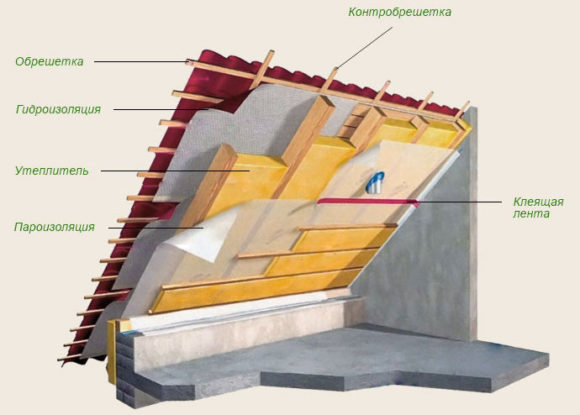
Advantages:
- Keeps rafters dry, thanks to good ability to pass moisture vapor;
- breathable material with good air exchange;
- high-quality soundproofing;
- not combustible, does not emit toxic substances;
- 55 years of operation;
- rodents do not start in it;
- can be mounted independently.
Disadvantages:
- there is a small amount of formaldehyde;
- if improperly mounted, it is deformed.
Styrofoam plates
This material is a foam. It is distinguished from ordinary packaging material by a higher density. Such plates are strong and solid, are difficult to mechanical destruction and withstand moisture.
Insulating the roof with such material is impractical. It burns well. In addition, rodents like to arrange their nests in it. If, nevertheless, a decision has been made to make thermal insulation from polystyrene foam, sheets with high density are taken.
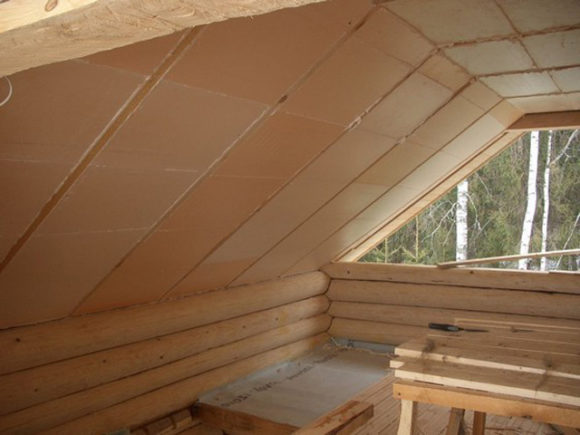
Advantages:
- does not harm health, does not emit toxic fumes;
- does not decay and does not decompose;
- does not burn and contains flame retardants;
- does not burden the roof structure;
- affordable price.
Disadvantages:
- damaged by mechanical stress;
- collapses from contact with nitro paint;
- low breathability;
- attracts rodents.
Polyurethane foam
This material has two components. It is a liquid substance, the two components of which are sold in separate containers. They are mixed before application in a special apparatus and applied in the form of foam on an insulated structure. In air, the mass quickly hardens, becomes solid and durable.
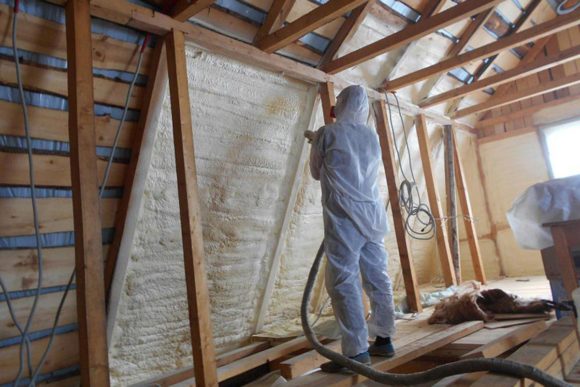
Polyurethane foam has the best thermal conductivity. For warming the attic, it would be ideal if the low cost and the need to use special equipment. Although now there are kits for independent use on sale. They have a small mass and include everything you need to use.
Advantages:
- well compatible with any base;
- suitable for surfaces with difficult terrain;
- due to its small mass, it does not burden the structure;
- strengthens the surface;
- gives a seamless coating.
Disadvantages:
- collapses from exposure to ultraviolet radiation;
- smoldering from the effects of fire.
Glass wool
This is one of the varieties of mineral wool. The raw materials for its manufacture are crystalline waste, including broken glass. Glass wool has long been used as insulation for roofs. It is especially suitable for the thermal insulation of complex structures. Glass wool fibers are three times the length of the fibers of other types of mineral wool. Therefore, this insulation is more durable.
When working with glass wool, they must protect the exposed areas of the body with a special suit and gloves from thin fibers, which, if they come into contact with the skin, cause irritation. A respirator is used to protect the respiratory system.
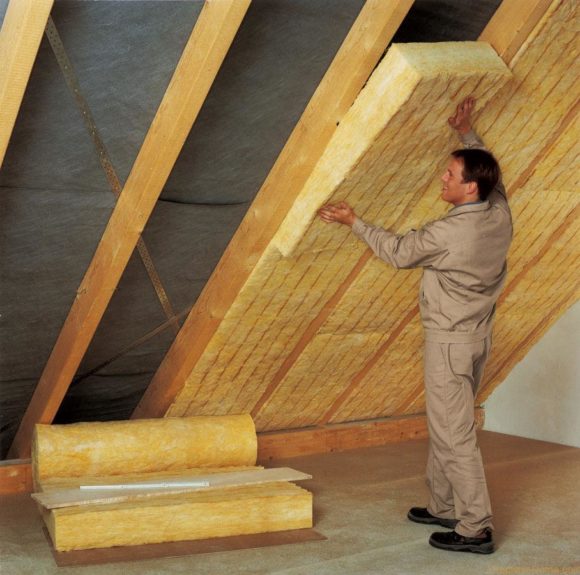
Advantages:
- low price;
- resistant to heat and fire;
- long service life;
- strong;
- weighs a little.
Disadvantages:
- absorbs water;
- with time, shrinkage appears and thermal insulation deteriorates;
- care must be taken during installation.
Ecowool
Such a heater was created recently and has not yet managed to become popular. Ecowool differs from other heaters by texture. It is available as a bulk substance. Its particles adhere to each other due to electrostatic forces.
The raw material for the production of ecowool is waste from the production of pulp. Thanks to its loose texture, ecowool is great for filling gaps. In terms of thermal insulation qualities, this insulation is not inferior to other types of mineral wool.
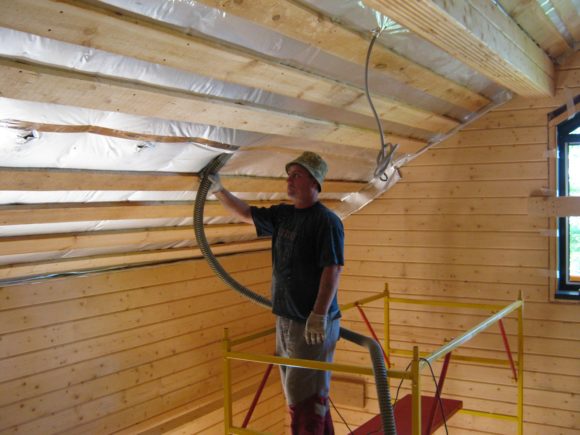
Due to its natural composition, insects and mold fungi are often found in ecowool. Often mice and rats arrange their nests in it. To improve fire-fighting qualities, ecowool is additionally treated with flame retardants.
Advantages:
- high vapor permeability;
- no toxic compounds in the composition;
- creates a seamless layer, perfectly fills the gaps;
- service life of 50 years.
Disadvantages:
- need a special spray for application;
- need to create an additional frame.
Stone wool
The basis for the production of stone wool is the rock basalt. Therefore, this insulation is also called basalt wool.Such a heater is quite expensive, but it differs from other types of mineral wool with an increased service life and good performance. During production, the raw material is exposed to high temperature and its fibers are bound with phenol formaldehyde.
Advantages:
- does not support combustion;
- good sound insulation;
- not destroyed by chemical attack;
- “Breathable” material;
- service life of 70 years;
- not subject to decay;
- does not attract rodents.
Disadvantages:
- thermal insulation is worse than that of foam;
- crumbles and dusts during laying;
- deforms from its own weight.
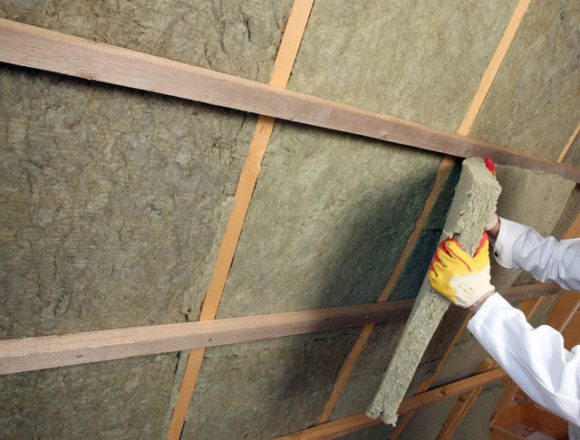
Room preparation
Before warming the attic, the entire lining is dismantled to open access to the rafters. Insulation is laid between them or on them. Then they check what condition the roof is in, whether there is steam and waterproofing.
If there are traces of leaks on the roof, first repair it and close all the cracks. Only then can we start the thermal insulation device.
Vapor barrier
This roof layer is very important. Therefore, it is usually done, even if the further use of the attic as a living space is not expected. If there is no such layer, it must be put. For this, the roofing material is removed from the outside. It cannot be made from the inside, since it is between the counter-lattice and the rafters.
Vapor barrier is made of different materials. In this case, the selection of a specific one is carried out on the basis of the technical characteristics of the material and its compatibility with the insulation.
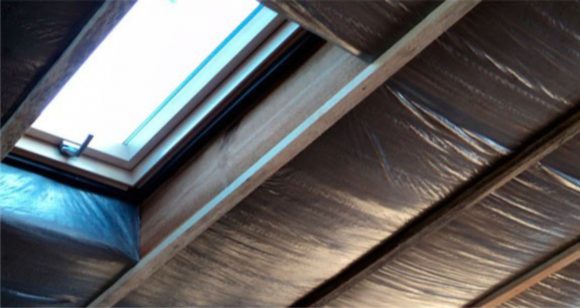
Polyethylene film
The material is very cheap, but despite this, it is not recommended for vapor barrier. It retains moisture, but also does not allow air to pass through. Because of this, there is no circulation and a “greenhouse effect” is created. Condensation accumulates on the film and impregnates the heat-insulating material with moisture.
The film collapses very quickly. Because of this, after a few years, the roof has to be dismantled and the vapor barrier changed.
Pergamine
This material has good waterproofing properties and is suitable for arranging vapor barrier. When working with it, you need to lay the material twice: between the roof and the counter-lattice, from the attic to the heater. With proper work in the attic, a favorable microclimate is created.
Outside, a double layer of glassine is laid under the roofing material. Then the vapor barrier efficiency will be optimal.
Any type of insulation is compatible with glazing, since such a vapor barrier reliably protects from moisture. But preference should be given to the fact that they are not attacked by rodents. You can choose mineral wool or penoplex.
Ruberoid
This is a long-known material used as waterproofing since Soviet times. If possible, get rid of it. This is due to rotting roofing material. Therefore, it is forbidden to use in buildings and capital structures. If this is not possible, an additional vapor barrier is laid.
Condensation builds up on the inside of the roofing material. Therefore, it is necessary to use vapor barrier together with it in the form of an additional layer of plastic film.
Isospan
This material was specially created for the vapor barrier device. Therefore, for covered residential attics it is better to use it. Izospan has a double-sided texture. Therefore, it collects condensate and does not allow it to penetrate the insulation. Drops are delayed by the rough side of the film and evaporate later. Izospan can also be used on attic walls.
Waterproofing membrane
An important function of this material is to protect the interior of the house from moisture. On sale there are different types of waterproofing membranes. To protect against steam, it is worth buying anti-condensation. She copes with vapor barrier better than others.
Penofol
This material simultaneously has a vapor barrier and warming effect.But you can use it only if you already have a waterproofing layer. Penofol has a reflective foil surface that collects condensate and evaporates it. In this case, the second side must be reliably protected from moisture. Then the material does its job well.
The need for waterproofing
If fibrous material is used as thermal insulation, moisture will be absorbed to a greater or lesser extent. Moisture gets on the fiber due to improperly installed roofs or the formation of condensation from temperature differences. Wet insulation is unable to function properly. Therefore, it is necessary to arrange waterproofing. For this, in modern construction using membrane materials. They prevent the formation of condensate and allow air vapors to pass through.
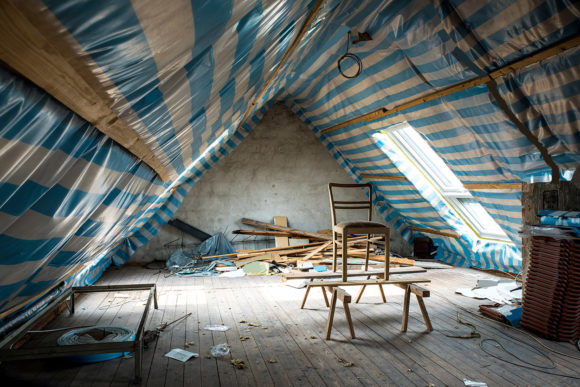
Material consumption and insulation scheme
The calculation of the required amount of materials is carried out during the inspection of the roof and the search for damage. The interval with which the rafters are installed, as well as the distance from the inner space to the vapor barrier, are taken into account. The internal space determines the required number of plates and their thickness. The interval between the rafters determines the size of the insulation.
If the installation interval of the rafters is more than 0.6 m, additional rails are prepared on their own to fix the insulation.
For sprayed insulation, the amount of work is taken into account. To do this, determine the perimeter of the attic, the height of the wall and the desired thickness of the layer. Then, depending on the density of the insulation, the desired volume of material is calculated. When calculating take into account window and door openings. For the convenience of calculations, it is better to use a special calculator.
The location of the insulation looks like this:
- The roofing material located in the upper layer is not touched. It relies on a crate and a counter-crate. They serve as a frame.
- Then come the initial layers of hydro and vapor barrier.
- Under waterproofing, a heater is mounted. Here, a variant with an additional crate is possible if the distance between the rafters is large.
- Then the vapor barrier is fixed from the side of the attic room.
- Finishing work.
Insulation of the attic from the inside for living in winter
After choosing a heat-insulating material, they begin to lay it under the roof in the attic. When performing work in any way, the insulation thickness is made such that it coincides with the width of the rafter legs. The width of the laid material is taken a little more than the interval between the rafters.
How to insulate the attic with mineral wool
The insulation is laid out on a flat surface in one layer and the strip width is measured. It corresponds to the distance between the rafters plus 2 cm. Thanks to this allowance for mineral wool, the gap between the rafters will fit tightly and will reliably protect from the cold.
Then the cut off strip of insulation is laid in the right place between the rafter legs. Sometimes, with a gentle slope of the roof, the mineral wool falls out of the rafters under its own weight. To prevent this, the rails are fastened to the rafters in the transverse direction on temporary self-tapping screws. If there are no slats, carnations are stuffed on the rafters in a checkerboard pattern and a thread is pulled between them.
After that, the created structure is closed with a film for waterproofing. It will protect the hygroscopic thermal insulation material from moist air, which reduces its working properties. The waterproofing is stacked from bottom to top, with overlapping panels and nailing with cloves.
When one layer of mineral wool is not enough to fill the space to the width of the rafters, a second layer of material is laid. In this case, the upper sheets are laid with an offset.
How to insulate the attic with polystyrene foam
Polyfoam or polystyrene foam slabs are one of the most affordable options for roof insulation. They are recommended to be used if there is no vapor or waterproofing membrane under the roofing material.This is possible due to very low water absorption.
Foam plates are cut according to the distance between the rafter legs. The prepared material is laid in the scheme of the rafter legs so that there is a little free space between it and the roofing. It is necessary to remove wet air vapors and harmful vapors released by the foam.
On top of the first layer, the foam is laid again so that its sheets cover the rafters. This design will protect against the penetration of cold air, which penetrates into the gaps between the rafters and the first layer of insulation. The second layer is attached to the rafters with self-tapping screws with a wide head.
How to insulate the attic with polyurethane foam
This insulation of the latest generation has a high degree of adhesion. It does not require preliminary surface preparation, since it adheres well to any building material. To work with it, you need a special compressor unit, which is collected directly in the attic. The material is applied in layers, achieving complete filling of the space between the rafters.
Features of applying polyurethane foam:
- The application of polyurethane foam is performed in a ventilated room.
- Work is performed in special clothing, shoes and mittens.
- The components of the insulation are mixed in equal amounts.
Roof insulation with complex geometry
It is not always that during construction they make a roof with even slopes in one plane. Sometimes the roof is broken. In general, the insulation of such a roof does not differ from the classical case. Especially if polyurethane foam is used as insulation. It is simply applied with the right layer.
In the case of a roof of complex design, there are areas with different rafters. In these places, there is a high probability of cold air coming from outside. Therefore, in such places they make non-joint installation of insulation. For this purpose, it is better to use mineral wool. Due to its flexibility, you can create any design and gently close the transition between the slopes.
Often in the case of a broken roof, the attic is made with a ceiling, which is installed at a level where the roof changes terrain. Therefore, they perform the insulation of walls located in the same plane, then go to the ceiling device and warm it. Sometimes the upper slope is not insulated and insulation is done only on the ceiling.
Possible mistakes
For thermal insulation, mineral wool is used only on roofs where a vapor barrier is created. Such protection removes air vapors located in the thickness of the insulation. Between the insulation and the roof, there is a certain amount of free space left so that the roof is ventilated. For this reason, the roofing material is laid on a crate mounted on a counter-crate.
For roofs with an inclination angle of slopes of less than 13 degrees, the attic is not organized. Snow comes off very badly from such a roof, so the risk of leaks increases significantly. If the thickness of the material for thermal insulation exceeds the width of the rafters, then the rails are nailed to their lower edge.
If it is necessary to mount skylights on roof windows, it is very important to make them airtight. It is difficult to cope with such a task independently without the necessary preparation. Therefore, it is better to invite a brigade for this.
When buying a cotton insulation, it is better to choose a material in the form of a mat, and not a rolled version. So you can save time and not wait until it lies down and cure. To insulate the floor in the attic, choose an inexpensive heater. Thermal insulation does not need to be additionally fixed, if necessary, this is done with rails, a construction stapler or duct tape.
Finally
You can insulate the attic yourself if you choose the right material. Most heaters are easy to install. Subject to all the rules, it is possible to make insulation on the roof within a few days.

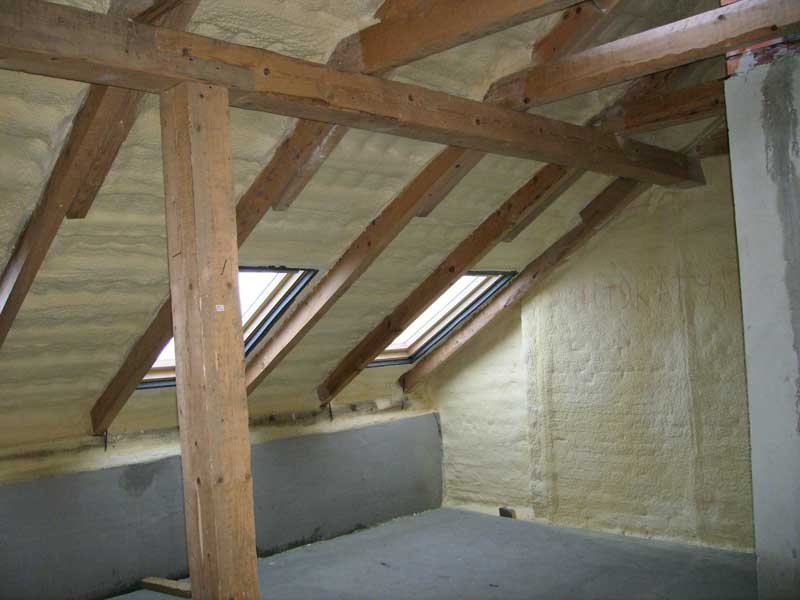



Alexander
It was very bitter to read stupid advice.
You have all mixed up with vapor barrier and waterproofing.
I want to give advice. Only you authors do not be offended.
You need to go to study before you teach other people.
Thanks.
Alexander Shalunov.
Alexander
Stupidity is written in an article, do not try to repeat people.